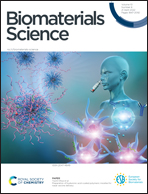Protein-mediated DNA self-assembly by controlling the surface charge in a molecular crowding environment†
Abstract
Designing and building artificial nanodevices and nanoarchitectures in living systems are extremely intriguing subjects in nanotechnology and synthetic biology. Taking advantage of cellular machinery and endogenous biomacromolecules, such as proteins, is key to achieving the precise and sophisticated manipulation of nanoarchitectures. In this study, we proposed a protein-mediated DNA self-assembly strategy in a molecular crowding environment. By carefully controlling the surface charge of basic nuclear proteins in a crowding environment that mimicked the intracellular environment, we demonstrated that highly positively charged protamine can assemble individual DNA strands into defined structures similar to a catalytic process manner. Successful self-assembly required an optimized protamine surface charge and a crowding environment; otherwise, this self-assembly was impossible. Polyacrylamide gel electrophoresis (PAGE), atomic force microscopy (AFM), and dynamic light scattering (DLS) results showed that tile-based DNA tubular structures, tetrahedra, and two dimensional DNA origami structures were successfully assembled. We inferred that the assembly process occurred between the arginine-rich domain of protamine and DNA strands that repeatedly interacted with each other in the viscous system. The current study provides a potential strategy to construct nanodevices in living systems and presents an alternative protein–DNA interaction for the potential fabrication of protein–DNA hybrid nanomaterials.



 Please wait while we load your content...
Please wait while we load your content...